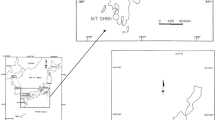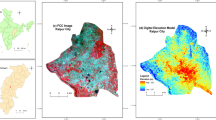Abstract
A comparative analysis of climatic and soil salinity characteristics of the deserts of Central Asia, including deserts of the Turan Depression, the Gobi Desert, and deserts of the Dzungar and Tarim depressions was performed. The climatic characteristics—the degree of aridity, the degree of continentality, and the amount and regime of precipitation—are different in these deserts. No direct relationships between the areas occupied by the automorphic salt-affected soils and the aridity of the climate are observed in the studied regions. In the automorphic landscapes of Asian deserts, the degree and chemistry of the soil salinization and the distribution of salt-affected soils are controlled by the history of the particular territories rather than by their modern climatic conditions. The presence and properties of the salt-bearing rocks and the eolian migration of salts play the most significant role. The deficit of moisture in the modern climate favors the preservation of salt accumulations in places of their origin. The specific features of the climate, including the regime of precipitation, affect the redistribution of salts in the profiles of automorphic salt-affected soils. An increase in the degree of climatic continentality is accompanied by the decrease in the intensity of weathering and initial accumulation of salts. A different situation is observed in the soils of hydromorphic desert landscapes, in which the degree of salinity of the surface horizons and the area occupied by salt-affected soils are directly influenced by the modern climatic conditions.
Similar content being viewed by others
References
M. I. Budyko, Global Ecology (Mysl’, Moscow, 1977) [in Russian].
N. F. Glazovskii, Modern Salt Accumulation in Arid Regions (Nauka, Moscow, 1978) [in Russian].
V. N. Dimo, Temperature Regime of Soils in the USSR (Kolos, Moscow, 1972) [in Russian].
N. N. Ivanov, “Landscape-climatic zones of the Earth,” Zap. Vsesouyzn. Geogr. O-va, Nov. Ser. (Leningrad, 1948), Vol. 1 [in Russian].
V. A. Kovda, Geochemistry of Deserts in the USSR (Izd. Akad. Nauk SSSR, Moscow, 1954) [in Russian].
United Nations Convention to Combat Desertification in Those Countries Experiencing Serious Drought and/or Desertification, Particularly in Africa (UNCCD) (Paris, 1994).
Kun Lun and Tarim: Environmental Sketches (Izd. Akad. Nauk SSSR, Moscow, 1961) [in Russian].
E. V. Lobova, “Classification of desert soils of the Subboreal zone,” in Geography and Classification of the Soils of Asia (Nauka, Moscow, 1965), pp. 11–38.
E. V. Lobova, I. M. Ostrovskii, and A. V. Khabarov, “On the determination of dryness in arid regions of the world,” Probl. Osvoen. Pustyn’, No. 4, 31–40 (1977).
E. V. Lobova and A. V. Khabarov, “Soil resources in arid and semiarid zones of the world,” in Arid Soils, Their Genesis, Geography, and Use (Nauka, Moscow, 1977), pp. 7–15 [in Russian].
E. M. Murzaev, Nature of Xinjiang and the Development of Deserts in Central Asia (Nauka, Moscow, 1966) [in Russian].
E. I. Pankova, Genesis of Salinization in Desert Soils (Moscow, 1992) [in Russian].
E. I. Pankova, “Environmental conditions and soils of natural oases in the Alashan Gobi Desert, Mongolia,” Eur. Soil Sci. 41(8), 827–836 (2008).
E. I. Pankova, “Facial specificity of soil salinization in ultracontinental deserts of the Subboreal zone of Asia,” Eur. Soil Sci. 35(11), 1157–1168 (2002).
E. I. Pankova, I. P. Aidarov, I. A. Yamnova, A. F. Novikova, and N. S. Blagovolin, Natural and Anthropogenic Salinization of Soils in the Aral Sea Basin: Geography, Genesis, and Evolution (Pochven. inst. im. V.V. Dokuchaeva RASKhN, Moscow, 1996) [in Russian].
E. I. Pankova and L. A. Vorob’eva, “Diagnostics and criteria of soil salinization,” in Salt-Affected Soils of Russia (IKTs Akademkniga, Moscow, 2006), pp. 6–50 [in Russian].
Soil Cover and Soils of Mongolia (Nauka, Moscow, 1984) [in Russian].
Environmental Conditions of Xinjiang (Izd. Akad. Nauk SSSR, Moscow, 1960) [in Russian].
Deserts of Trans-Altai Gobi (Nauka, Moscow, 1986), pp. 53–80 [in Russian].
Deserts (Mysl’, Moscow, 1986) [in Russian].
J. Abuduwaili, M. V. Gabchenko, and X. Junrong, “Eolian transport of salts - a case study in the area of Lake Ebinur (Xinjiang, Northwest China),” J. Arid Environm. 72(10), 1843–1852 (2008).
R. H. Behnke, Desertification: Causes, Impacts and Consequences (Springer, 2012).
H. E. Dregne, “Land degradation in the drylands,” Arid Land Res. Managem. 16(2), 99–132 (2002).
H. E. Dregne, Soils of Arid Regions (Elsevier, Amsterdam, 1976).
H. Geist, The Causes and Progression of Desertification (Ashgate, 2005).
M. Mainguet, Aridity: Droughts and Human Development (Springer, 1999).
Ye. I. Pankova and I. P. Aidarov, “Secondary salinization of soils in the Aral basin as a factor of anthropogenic desertification,” in Advances in Environmental Research, Vol. 2, 179–216 (Nova Science Publ., New York, 2010).
I. Szabolcs, “Impact of Climatic change on soil attributes. influence on salinization and alkalization,” in Soils on a Warmer Earth (Developments in Soil Science) (Elsevier, 1990), pp. 61–69.
I. Szabolcs, Salt Affected Soils (CRC Press, Boca Raton, 1989).
A. Trabucco and R. J. Zomer, Global Aridity Index (Global-Aridity) and Global Potential Evapo-Transpiratio (Global-PET) Geospatial Database (CGIAR-CSI, 2009) http://www.csi.cgiar.org. 2009.
Z. Wang, S. Zhu, R. Yu, L. Li, G. Shan, W. You, X. Zhen, C. Zhang, L. Zhang, R. Song, Saline Soils in China (Science Press, Beijing, 1993).
World Atlas of Desertification, 2nd ed. (UNEP, Nairobi, Kenya, 1997).
Author information
Authors and Affiliations
Corresponding author
Additional information
Original Russian Text © E.I. Pankova, M.V. Konyushkova, 2013, published in Pochvovedenie, 2013, No. 7, pp. 771–777.
Rights and permissions
About this article
Cite this article
Pankova, E.I., Konyushkova, M.V. Climate and soil salinity in the deserts of Central Asia. Eurasian Soil Sc. 46, 721–727 (2013). https://doi.org/10.1134/S1064229313070065
Received:
Published:
Issue Date:
DOI: https://doi.org/10.1134/S1064229313070065




